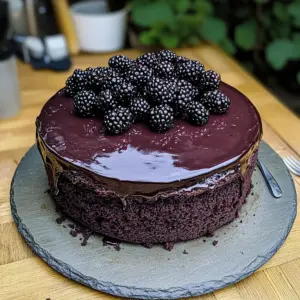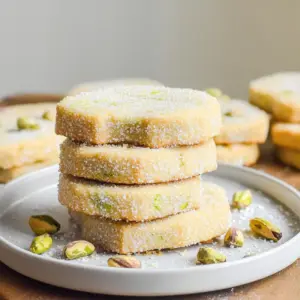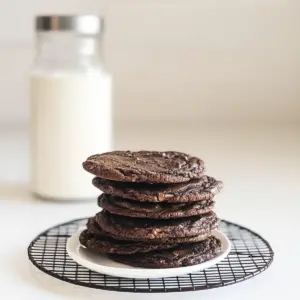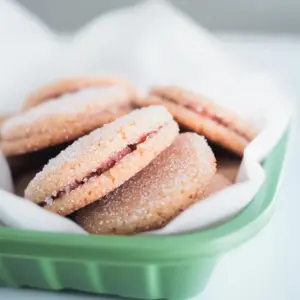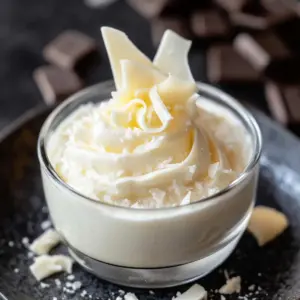The first bite of Japchae transports me straight to the bustling streets of Seoul, where the scent of sizzling noodles fills the air. This traditional Korean dish, featuring soft sweet potato glass noodles tossed with savory beef and vibrant vegetables, is not only a visual feast but also a delightful blend of flavors that brings comfort to any meal. What I adore about Japchae is its versatility—whether you stick to the classic beef version or switch things up with chicken or tofu, it appeals to everyone at the table. Plus, it’s incredibly quick to make, perfect for busy weeknights or impressing guests during a casual dinner party. Curious how to create this joyful, noodle-packed dish in your own kitchen? Let’s dive into the recipe!
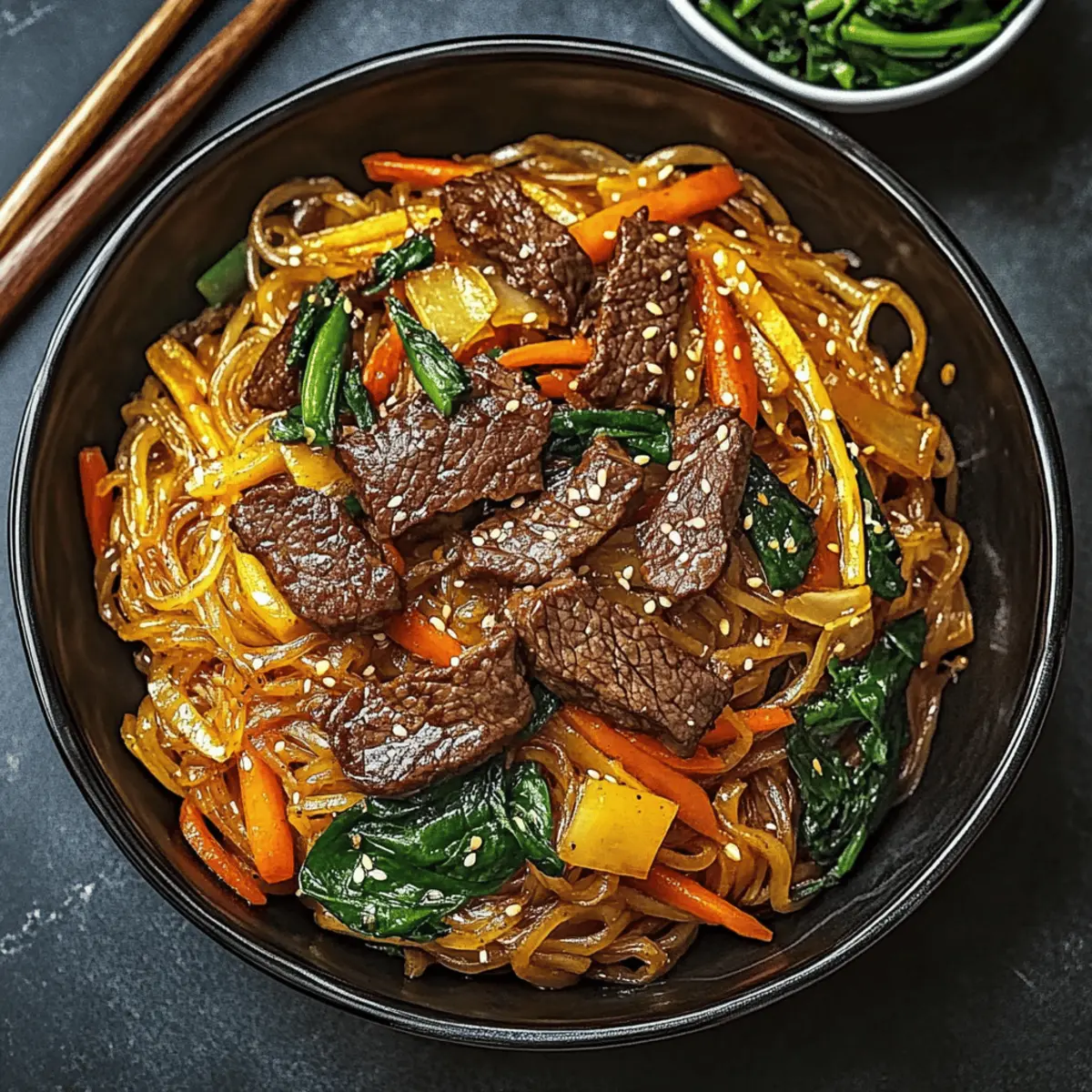
Why is Japchae so special?
Authentic Flavor: Japchae offers a delightful mix of sweet and savory, thanks to the perfect blend of soy sauce and sesame oil. Each bite bursts with richness that truly reflects traditional Korean cuisine.
Quick and Easy: Perfect for busy weeknights, this dish comes together in about 30 minutes, making it an ideal option for anyone craving homemade goodness without the wait.
Customizable Ingredients: With a variety of protein choices—like chicken, tofu, or beef—and a colorful array of vegetables, you can make this dish your own. Get creative and use up what you have on hand!
Family-Friendly: Appealing to both kids and adults, Japchae is a guaranteed hit at the dinner table, whether served as a main or side dish. Impress your guests or simply treat your family to something new.
Glossy Finish: Visually stunning, Japchae boasts a silky texture that makes it feel indulgent, ensuring that every plate looks as good as it tastes. Get ready for compliments!
Japchae Ingredients
For the Noodles
• Sweet Potato Glass Noodles (Dangmyeon) – These noodles are the star of Japchae, providing a chewy texture; substitute with rice noodles for a gluten-free option.
For the Protein
• Beef – Opt for tender cuts like sirloin for juicy flavor; you can substitute with chicken or tofu if desired.
For the Vegetables
• Carrots – Julienne cut for a sweet crunch; they add beautiful color and nutrition.
• Bell Peppers – Choose any color to brighten your dish; they can be swapped with other veggies like zucchini or mushrooms.
• Spinach – Adds brightness and nutrition; you can use bok choy or kale as alternatives.
• Onions – Sautéed for a hint of sweetness; substitute with shallots if you prefer a milder taste.
For the Sauce
• Soy Sauce – This adds depth and umami to your Japchae; opt for low-sodium soy sauce for a healthier version.
• Sesame Oil – Imparts a nutty aroma to the dish; olive oil can be used for a lighter touch.
• Sugar – Balances the flavors; adjust according to your taste or omit for less sweetness.
For Garnish
• Green Onions – Adds a fresh crunch; can be excluded if you don’t have any on hand.
Embark on your culinary adventure with these Japchae ingredients, and enjoy the delightful mix of flavors and textures!
Step‑by‑Step Instructions for Japchae
Step 1: Prep Noodles
Begin by soaking 8 ounces of sweet potato glass noodles in a bowl of hot water for about 30 minutes. You’ll know they’re ready when they become pliable and nearly transparent. Once softened, drain the noodles and set them aside to allow extra moisture to evaporate while you prepare the other ingredients.
Step 2: Stir-Fry Protein
Heat a large skillet or wok over medium-high heat, and add a splash of oil. Once shimmering, toss in 8 ounces of thinly sliced beef (or your chosen protein) and stir-fry for about 3-4 minutes until browned and cooked through. Remove the protein from the pan and set it aside, leaving any delicious juices behind for the vegetables.
Step 3: Sauté Vegetables
In the same skillet, add another drizzle of oil and heat it over medium-high. Add 1 sliced onion, 1 julienned carrot, and 1 bell pepper (any color you prefer). Stir-fry these vibrant vegetables for about 4-5 minutes until they soften but still retain a little crunch. Finally, add a couple of handfuls of spinach, cooking just until wilted, approximately 1 minute.
Step 4: Combine Ingredients
Now, add the drained sweet potato noodles and your cooked protein back into the skillet with the sautéed vegetables. Pour in 4 tablespoons of soy sauce, 2 tablespoons of sesame oil, and 1 tablespoon of sugar. Toss everything together vigorously for about 2-3 minutes, ensuring all the ingredients are well-coated and heated through, achieving the beautiful, glossy finish characteristic of Japchae.
Step 5: Serve
Once everything is combined and heated through, transfer the freshly made Japchae to a serving platter. For a delightful touch, garnish with chopped green onions and a sprinkle of sesame seeds if desired. This colorful dish is now ready to impress your family and friends!
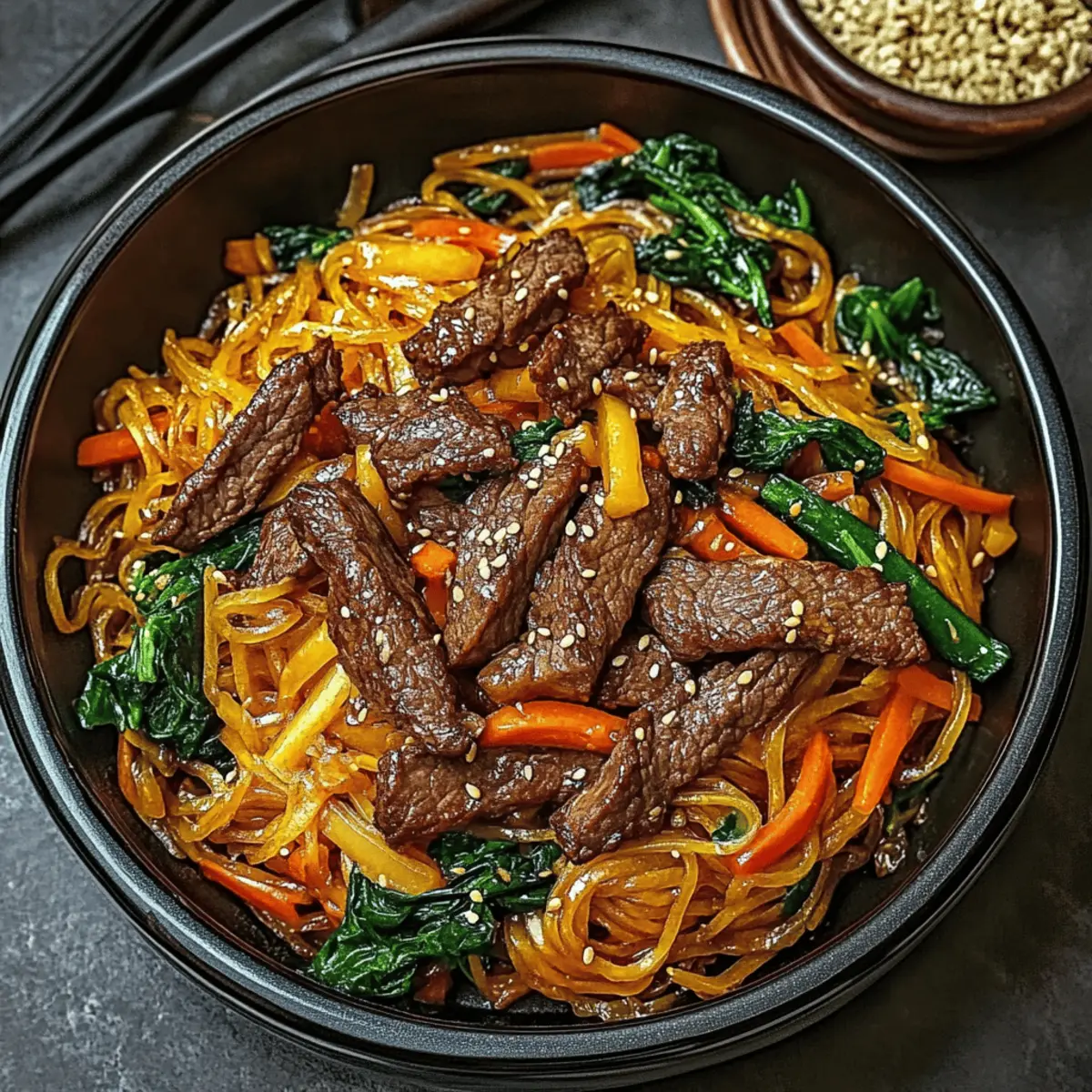
Make Ahead Options
These Japchae are perfect for busy home cooks looking to save time during the week! You can prepare the sweet potato glass noodles and sauté the vegetables up to 24 hours in advance. Soak and drain the noodles, and store them in an airtight container. Similarly, stir-fry your choice of protein and store it separately. When you’re ready to serve, just combine all the components in a hot skillet with soy sauce, sesame oil, and sugar for about 3-5 minutes until heated through. This way, you’ll have delicious, homemade Japchae ready to enjoy with minimal fuss, offering that comforting homemade feel without the rush!
Japchae Variations & Substitutions
Feel free to get creative with this delightful dish and make it uniquely yours!
- Gluten-Free: Substitute sweet potato noodles with rice noodles to cater to dietary restrictions without sacrificing flavor.
- Vegetarian Protein: Use tofu or tempeh for a hearty, plant-based version that soaks up all the wonderful flavors.
- Spicy Kick: Stir in a teaspoon of gochujang for a tantalizing heat that elevates the dish, perfect for spice lovers.
- Veggie Boost: Add mushrooms or broccoli for extra nutrition and an earthy flavor; they pair wonderfully with the sweet potato noodles.
- Enhanced Umami: Include a splash of oyster sauce or vegetarian oyster sauce for depth in flavor that will elevate your Japchae.
- Seasonal Twist: Use seasonal vegetables like zucchini or asparagus to keep things fresh and vibrant throughout the year.
- Nutty Finish: Top with toasted sesame seeds or crushed peanuts for an added crunch that brings a delightful texture contrast.
- Chili Oil: Drizzle a little chili oil on top for a smoky, spicy dimension that can transform your dish into an exciting flavor experience.
If you’re interested in exploring even more variations, consider checking out ideas for customizing with seasonal vegetables or learning about other noodle alternatives to keep your meals exciting!
Expert Tips for Japchae
-
Noodle Soaking: Ensure the sweet potato noodles are soaked long enough until they’re pliable; under-soaking can lead to a tough texture when cooked.
-
High Heat Cooking: Always stir-fry on high heat to achieve that signature glossy finish and enhance flavors; a well-heated pan prevents ingredients from steaming.
-
Veggie Variations: Feel free to mix and match vegetables based on what’s in season or available; just avoid adding too many at once to maintain crispness.
-
Protein Substitutions: If substituting proteins like chicken or tofu, cut them into even pieces for uniform cooking; this ensures everything gets that delicious stir-fry flavor.
-
Taste as You Go: Always sample while cooking; adjust the soy sauce and sugar to get the balance just right for your palate in this delightful Japchae.
-
Storage Tips: Store any leftovers in an airtight container in the fridge for up to 3 days, but avoid reheating in the microwave to keep textures intact.
How to Store and Freeze Japchae
Fridge: Store leftover Japchae in an airtight container for up to 3 days. Make sure to cool it completely before refrigerating to keep it fresh.
Freezer: For longer storage, freeze Japchae in a freezer-safe container for up to 2 months. Consider portioning it out for easy thawing and reheating.
Reheating: When you’re ready to enjoy again, reheat the frozen Japchae in a skillet over medium heat, adding a splash of water or soy sauce to keep it moist. Avoid microwaving to maintain the noodle’s chewy texture.
Special Tip: If you’re concerned about freezer burn, wrap your Japchae in plastic wrap before placing it in an airtight container for optimal freshness.
What to Serve with Japchae
To create a memorable meal around your delightful plate of Japchae, consider these enticing pairings that perfectly complement its unique flavors.
-
Korean Fried Chicken: Crispy and savory, it adds a crunchy contrast to the chewy noodles, making every bite an adventure. The bold flavors of garlic and spice harmonize beautifully with the sweetness of the Japchae.
-
Steamed Rice: Simple and comforting, white or brown rice can soak up any extra sauce, allowing you to enjoy each delicious flavorfully. It’s an ideal base to enhance the dish’s vibrant characteristics.
-
Kimchi: This traditional fermented side dish brings a delightful tanginess and spiciness that balances the sweetness of Japchae, awakening your palate for each bite. Plus, it’s packed with probiotics for a healthy twist!
-
Vegetable Tempura: The crispy texture of lightly battered vegetables adds a fun crunch, enhancing the meal’s overall texture while providing a lighter complement to the rich flavors of Japchae.
-
Seaweed Salad: Refreshing and slightly sweet, this salad offers a cool, crisp bite that contrasts well with the warmth of the stir-fried noodles. Its ocean-inspired flavors enhance the overall dining experience.
-
Mango Mousse: For dessert, this light and fluffy treat serves as a sweet finale, balancing the savory elements of the meal. Its tropical notes transport you to a sunny beach with every luscious spoonful.
-
Cold Soju or Beer: These popular Korean beverages cool down the palate and enhance the spices and flavors, making them perfect companions for your Japchae feast. Whether enjoyed on a warm day or during a gathering, they elevate the occasion.
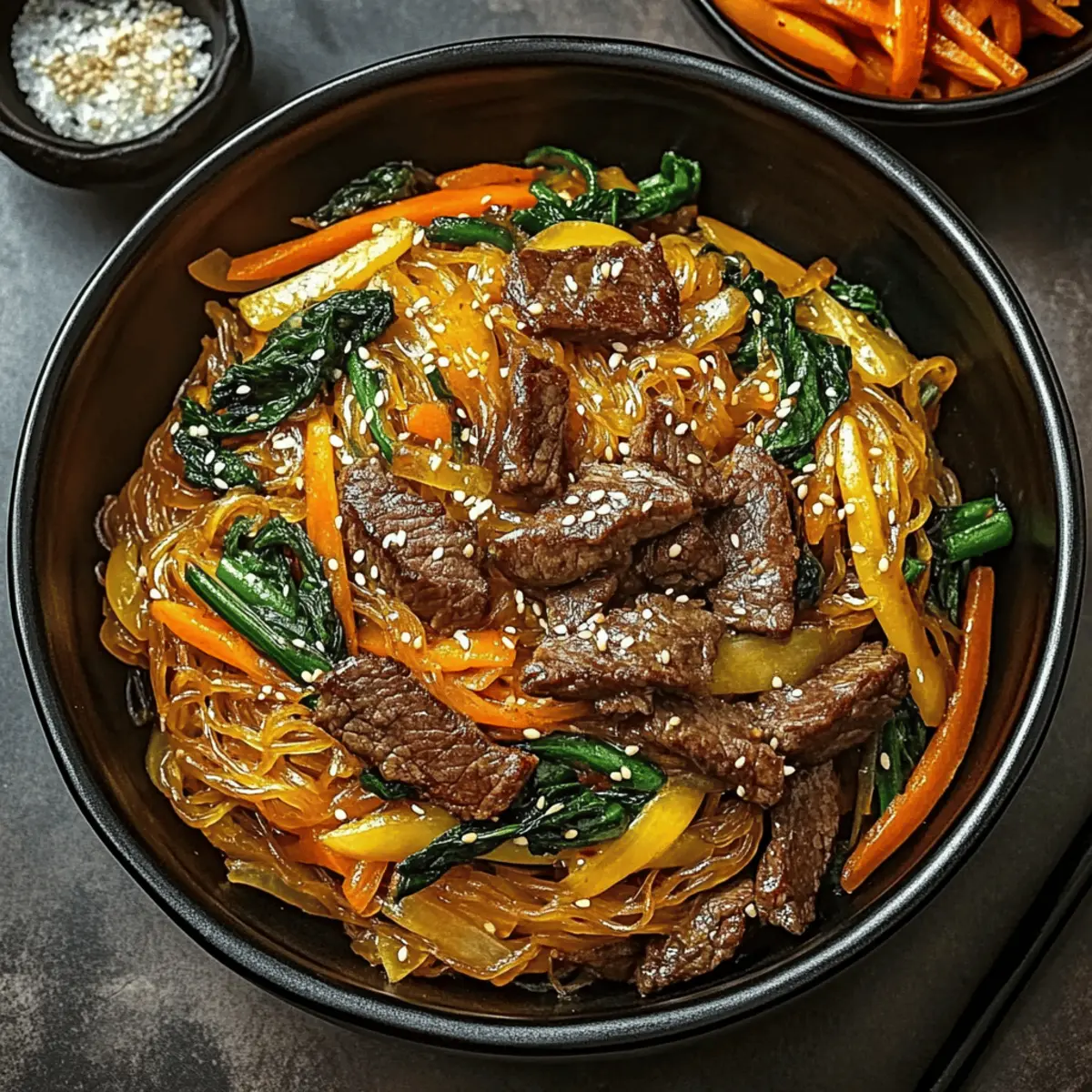
Japchae: Traditional Korean Stir-Fried Sweet Potato Noodles with Beef and Vegetables Recipe FAQs
What type of glass noodles should I use for Japchae?
You should use sweet potato glass noodles (Dangmyeon) for the traditional texture. These noodles provide a chewy consistency that makes Japchae unique. If you need a gluten-free option, you can substitute them with rice noodles. Just remember that cooking times may vary slightly.
How should I store leftover Japchae?
Store your leftover Japchae in an airtight container in the fridge for up to 3 days. Make sure it has cooled completely before sealing it to preserve freshness. When you’re ready to enjoy it again, reheat gently on the stovetop for the best texture.
Can I freeze Japchae?
Absolutely! To freeze Japchae, first allow it to cool down completely. Then, portion it into freezer-safe containers and keep it frozen for up to 2 months. When you’re ready to eat, reheat in a skillet over medium heat, adding a splash of water or soy sauce to keep it moist.
What should I do if my noodles are tough?
If your noodles turn out tough, it’s usually due to insufficient soaking or cooking time. Always soak the sweet potato noodles in hot water for about 30 minutes until they are pliable. When cooking, ensure you’re stir-frying on high heat for just 2-3 minutes to retain their texture. If they are still not to your liking, try soaking them longer next time.
Are there any dietary considerations for Japchae?
Yes, Japchae can be customized to meet various dietary needs. For gluten-free options, use gluten-free soy sauce and rice noodles. For a vegetarian dish, substitute beef with tofu or omit it entirely. It’s essential to be mindful of allergies related to specific vegetables or sauces, such as soy or sesame, and adjust the ingredients accordingly.
How do I know when the vegetables are cooked just right?
You want your vegetables in Japchae to be tender yet still crisp. Sauté them until they soften slightly, which typically takes about 4-5 minutes on high heat. A good trick is to keep an eye on their colors; they should maintain their vibrancy. Adding spinach last is a great way to ensure they just wilt and retain their nutrients!
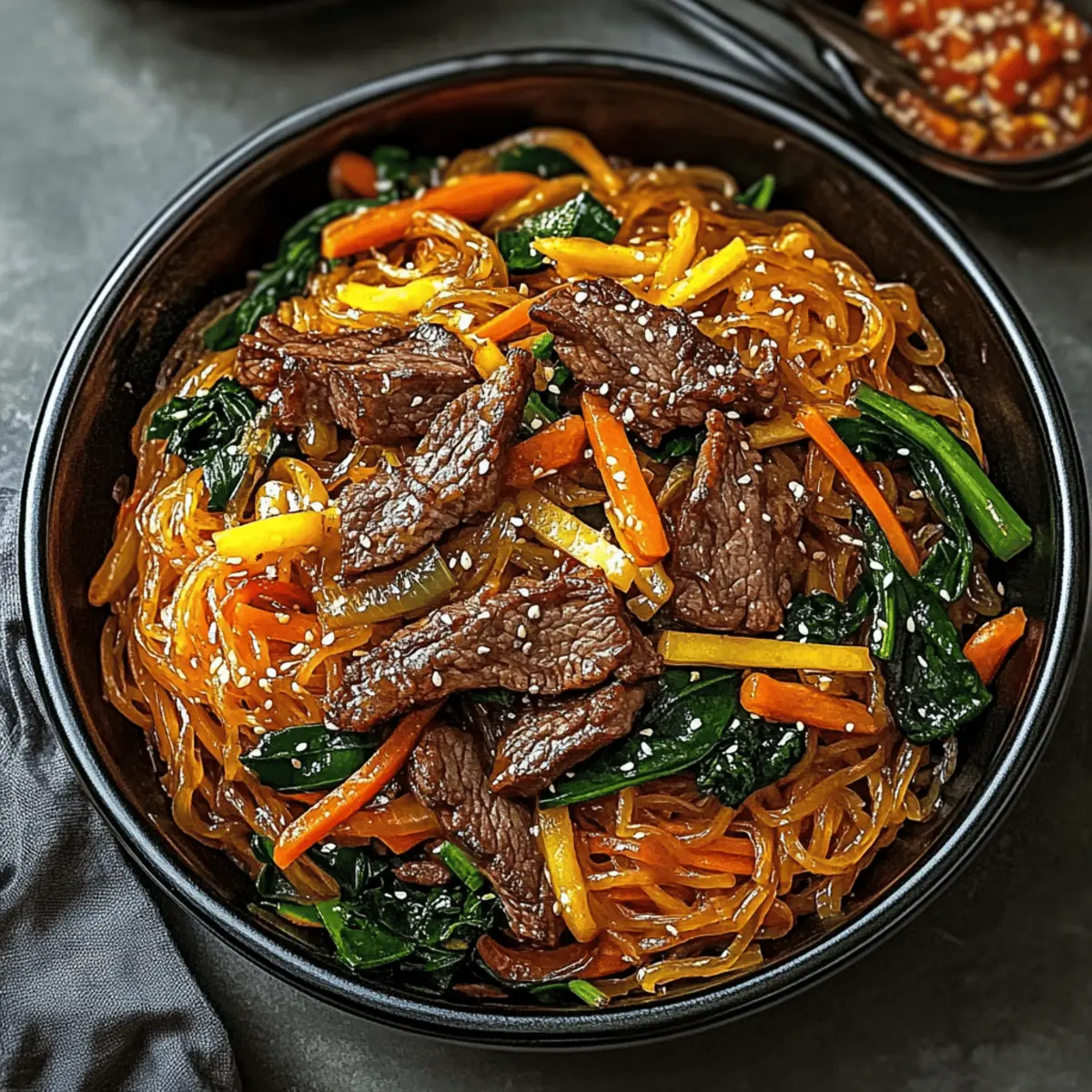
Delicious Japchae: Your Ultimate Korean Stir-Fried Noodles Guide
Ingredients
Equipment
Method
- Soak 8 ounces of sweet potato glass noodles in a bowl of hot water for about 30 minutes until pliable and nearly transparent. Drain and set aside.
- Heat a large skillet over medium-high heat, add oil, and stir-fry 8 ounces of thinly sliced beef for 3-4 minutes until browned. Remove from the pan.
- Add oil to the same skillet, heat, and stir-fry 1 sliced onion, 1 julienned carrot, and 1 bell pepper for 4-5 minutes until softened. Add a couple of handfuls of spinach, cooking just until wilted.
- Add the drained sweet potato noodles and cooked protein back to the skillet, pour in 4 tablespoons of soy sauce, 2 tablespoons of sesame oil, and 1 tablespoon of sugar. Toss everything together for 2-3 minutes.
- Transfer the Japchae to a serving platter, garnish with chopped green onions and sesame seeds if desired.




